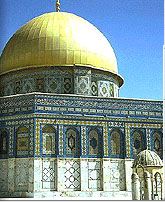|

The Restoration of the Temple Mount and its Plan
|
The Muslims' intention to erect religious buildings on Temple Mount required that they
restore walls that had been in ruins since their destruction by the Romans in 70 CE. Repairs were also required in later centuries of Islamic rule due to the havoc wreaked by earthquakes. These repairs did not alter the basic plan of the Herodian Temple Mount, but introduced minor additions, such as the relocation of entranceways. |
|
The Umayyad restoration work included rebuilding walls to their original height - especially evident in the heavily damaged southern wall of the Temple Mount. The subterranean spaces, known as 'Solomon's Stables' were then constructed using stones smaller than the ones used during the Second Temple period. The Islamic builders imitated the original concept of staggered walls, each course of stones somewhat regressed in relation to the row beneath. The Umayyad reconstruction closely resembled the original edifice, with the exception of some unique Second-Temple-period elements, such as the engaged pilasters and the margins around the Herodian stones. It is important to note that although the Umayyad 'Palaces' were constructed of re-used Herodian architectural elements from the Roman debris, they did not use any of them for the restoration of the Temple Mount walls. |
The dimensions of the Temple Mount (Haram ash-Sharif) were the same as those of the Herodian edifice (700 x 1000 ells). It was paved with flagstones. Around the Haram walls - in the north, west and between the southwestern corner and the Al-Aqsa Mosque - ran colonnades that supported the ceilings. The colonnades were of marble, and parts of the ceilings - at least the ones in the north - were studded with mosaics.
The Roman destruction of the Temple Mount included the destruction of its gates. Some of the gates were blocked, but most were rebuilt and new ones were added. Following the restoration work of the Islamic period, the old gates as well as other sites on Temple Mount were renamed. Four different Islamic sources (Ibn al-Fakih, Ibn `Abd Rabbih, al-Muqaddasi and Nasir-i-Khusrau) and two Jewish sources (the Jerusalem Guide and the Cairo Geniza) mention eleven gates that led to the Temple Mount during the Islamic period. The first two sources - Ibn al-Fakih, Ibn Abd Rabbih - are geographers of the tenth century CE, but there are many discrepancies between them. The sources of al-Muqaddasi (end of the tenth century) and Nasir-i-Khusrau (eleventh century) are more reliable. Today there are 17 gates leading to the Temple Mount: ten in the west, three in the north, three in the south and one in the east. The southern and eastern gates are currently blocked, as are two of the ancient gates in the west. |

|


